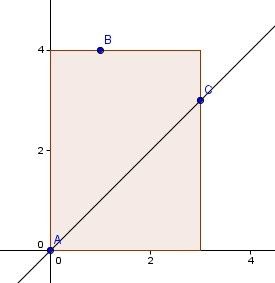poj 3241 Object Clustering 莫队算法,曼哈顿最小生成树
| Time Limit: 2000MS | Memory Limit: 131072K | |
| Total Submissions: 1732 | Accepted: 432 |
Description
We have N (N ≤ 10000) objects, and wish to classify them into several groups by judgement of their resemblance. To simply the model, each object has 2 indexes a and b (a, b ≤ 500). The resemblance of object i and object j is defined by dij = |ai - aj| + |bi - bj|, and then we say i is dij resemble to j. Now we want to find the minimum value of X, so that we can classify the N objects into K (K < N) groups, and in each group, one object is at most X resemble to another object in the same group, i.e, for every object i, if i is not the only member of the group, then there exists one object j (i ≠ j) in the same group that satisfies dij ≤ X
Input
The first line contains two integers N and K. The following N lines each contain two integers a and b, which describe a object.
Output
A single line contains the minimum X.
Sample Input
6 2 1 2 2 3 2 2 3 4 4 3 3 1
Sample Output
2
Source
转载请注明出处,谢谢http://blog.csdn.net/ACM_cxlove?viewmode=contents by---cxlove
二维平面中有一些点,两点之间的距离为曼哈顿距离,求最小生成树。朴素的n个点,只能做到O(n^3)或者O(n^2 lgn)。但是针对这种曼哈顿距离的MST。其中有个性质是:对于某个点,以他为中心的区域分为8个象限,对于每一个象限,只会取距离最近的一个点连边。这样的话,由于边是双向的,所以对于每个点只需要考虑4个方向,边的数目最多为O(4*n),再使用kruskal就可以做到O(nlgn)了。至于证明:这个结论可以证明如下:假设我们以点A为原点建系,考虑在y轴向右45度区域内的任意两点B(x1,y1)和C(x2,y2),不妨设|AB|≤|AC|(这里的距离为曼哈顿距离),如下图:
|AB|=x1+y1,|AC|=x2+y2,|BC|=|x1-x2|+|y1-y2|。而由于B和C都在y轴向右45度的区域内,有y-x>0且x>0。下面我们分情况讨论:
1. x1>x2且y1>y2。这与|AB|≤|AC|矛盾;
2. x1≤x2且y1>y2。此时|BC|=x2-x1+y1-y2,|AC|-|BC|=x2+y2-x2+x1-y1+y2=x1-y1+2*y2。由前面各种关系可得y1>y2>x2>x1。假设|AC|<|BC|即y1>2*y2+x1,那么|AB|=x1+y1>2*x1+2*y2,|AC|=x2+y2<2*y2<|AB|与前提矛盾,故|AC|≥|BC|;
3. x1>x2且y1≤y2。与2同理;
4. x1≤x2且y1≤y2。此时显然有|AB|+|BC|=|AC|,即有|AC|>|BC|。
综上有|AC|≥|BC|,也即在这个区域内只需选择距离A最近的点向A连边。
转自: http://blog.csdn.net/huzecong/article/details/8576908那么如果有了结论之后,怎么样筛选出每个区域最近的点首先是8个方向,由于边的双向性,我们只需要针对一个点考虑4个方向即可。这4个方向(比如说Y轴右侧),那么都可以通过坐标变换到某一个区域,(比如说y>x)。关于y=x或者y=0对称就可以实现。对于y>x这个区域,如果对于点A(x0,y0) 在这个区域中有个点B(x1,y1)。那么x1>x0&&y1-x1>y0-x0。而dist(A,B)=x1-x0+y1-y0=x1+y1-(x0+y0),那么对于点A,则是找在这个区域内x1+y1最小的点。那么什么样的点满足在这个区域内呢,(X1>X0&&Y1-X1>Y0-X0)便 是条件我们将坐标按X排序,将Y-X离散化,用BIT来维护,查询对于某一个X0,查询比(Y0-X0)大的中X1+Y1最小的点。将这条边加上,重复4个区域之后,就是kruskal了。
我的方法:原理用的是如上的。
实现的时候,也是计算y>x的区域的。但是树状数组以x-y离散化的结果排序的。
因为y'-x' > y-x
所以x'-y' < x-y
其实树状数组不仅可以实现前缀和,也可以实现后缀和,没必要反过来的。但是我就是习惯了
#include<iostream>
#include<cstring>
#include<cstdio>
#include<math.h>
#include<algorithm>
#include<vector>
using namespace std;
#define maxn 10007
#define inf 100000000
#define maxm 2007
int pos[maxm],tree[maxm];
void add(int p,int val,int id){
while(p < maxm){
if(val < tree[p]){
tree[p] = val;
pos[p] = id;
}
p += p&(-p);
}
}
int query(int p){
int id=-1,val=inf;
while(p > 0){
if(tree[p] < val){
val = tree[p];
id = pos[p];
}
p -= p&(-p);
}
return id;
}
struct Node{
int x,y,id,xsy;
};
int comp(Node a,Node b){
if(a.x == b.x) return a.y > b.y;
return a.x > b.x;
}
int compxsy(Node a,Node b){
return a.xsy < b.xsy;
}
struct Edge{
int u,v,w;
Edge(int _u=0,int _v=0,int _w=0){
u =_u,v=_v,w=_w;
}
};
vector<Edge> edge;
Node point[maxn];
Node P[maxn];
int dist(Node a,Node b){
return abs(a.x-b.x)+abs(a.y-b.y);
}
void ManhaTon(int n){
for(int i = 0;i < n; i++)
point[i].xsy = point[i].x-point[i].y;
sort(point,point+n,compxsy);
int cnt = 1,f=-inf;
for(int i = 0;i < n; i++){
if(point[i].xsy != f){
cnt++;
f = point[i].xsy;
}
point[i].xsy = cnt;
}
sort(point,point+n,comp);
for(int i = 0;i < maxm; i++)
tree[i] = inf,pos[i]=-1;
for(int i = 0;i < n; i++){
int u = point[i].id;
int v = query(point[i].xsy);
if(v != -1)
edge.push_back(Edge(u,v,dist(P[u],P[v])));
add(point[i].xsy,point[i].x+point[i].y,u);
}
}
void buildEdge(int n){
edge.clear();
for(int j = 0;j < 4; j++){
for(int i = 0;i < n; i++)
point[i] = P[i];
for(int i = 0;i < n; i++){
if(j == 1) swap(point[i].x,point[i].y);
else if(j == 2)
point[i].y = -point[i].y;
else if(j==3){
swap(point[i].x,point[i].y);
point[i].y = -point[i].y;
}
}
ManhaTon(n);
}
}
int pre[maxn];
int find(int u){
if(u == pre[u]) return u;
return pre[u] = find(pre[u]);
}
int compEdge(Edge a,Edge b){
return a.w < b.w;
}
int MST(int n,int k){
for(int i = 0;i < n; i++)
pre[i] = i;
sort(edge.begin(),edge.end(),compEdge);
int d = 0;
for(int i = 0;i < edge.size() ;i++){
if(n == k) return d;
d = edge[i].w;
int f1 = find(edge[i].u);
int f2 = find(edge[i].v);
if(f1 == f2) continue;
pre[f1] = f2;
n--;
}
return d;
}
int main(){
int n,k;
while(scanf("%d%d",&n,&k)!=EOF){
for(int i = 0;i < n; i++){
scanf("%d%d",&P[i].x,&P[i].y);
P[i].id = i;
}
buildEdge(n);
printf("%d\n",MST(n,k));
}
return 0;
}
